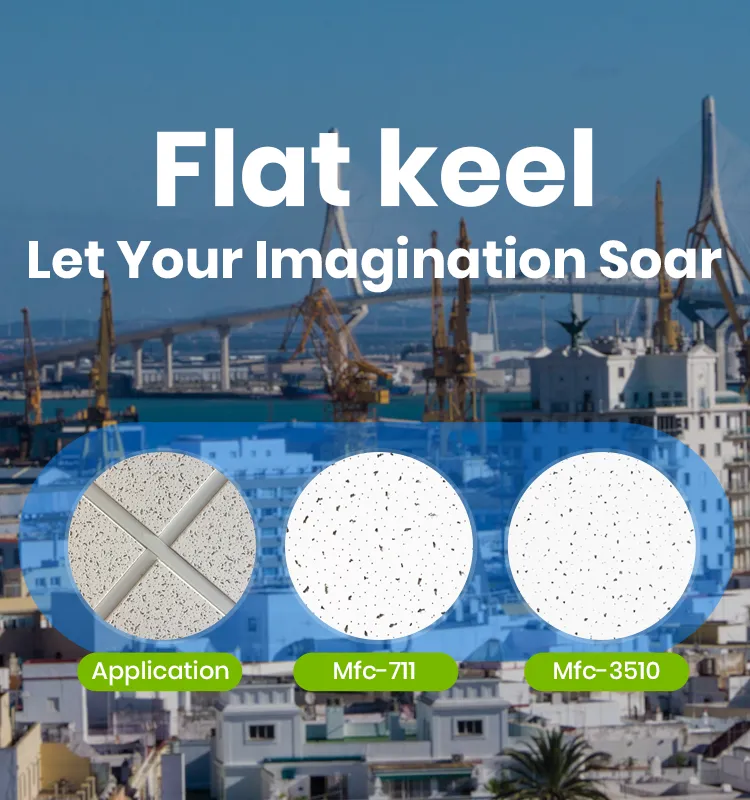Nov . 10, 2024 11:20 Back to list
Installing a Suspended Ceiling Grid for Drywall Applications
Understanding Suspended Drywall Ceiling Grid A Comprehensive Overview
When it comes to interior construction and design, the suspended drywall ceiling grid is a versatile and practical solution that has gained immense popularity in commercial and residential spaces alike. This system not only provides a clean and modern aesthetic but also enhances functionality by accommodating various building utilities and improving acoustics. This article delves into the key aspects of suspended drywall ceiling grids, including their components, installation, benefits, and applications.
What is a Suspended Drywall Ceiling Grid?
A suspended drywall ceiling grid, often referred to as a drop ceiling or false ceiling, consists of a grid framework that is suspended from the existing ceiling structure. This framework serves as a support system for drywall panels, which can be easily installed and finished to create a smooth and seamless ceiling surface. The grid is usually made from metal or lightweight materials, ensuring durability while allowing for adaptability in design.
Components of the Ceiling Grid System
The primary components of a suspended drywall ceiling grid include
1. Main Runners These are the long, horizontal pieces that provide the primary structure for the ceiling. They are typically installed parallel to the longest wall of the room. 2. Cross Tees These connect the main runners and create a grid-like structure. The length of cross tees may vary, offering flexibility in panel size and layout.
3. Wall Angles Installed at the perimeter of the grid, wall angles support the edges of the drywall panels and create a clean finish along the walls.
4. Hangers and Support Wires These are used to suspend the grid from the overhead structure, ensuring a sturdy support system that can accommodate the weight of the drywall panels.
5. Drywall Panels These come in various sizes and thicknesses to fit the grid layout and provide a smooth finish to the ceiling.
Installation Process
Installing a suspended drywall ceiling grid requires careful planning and execution. The process typically involves
1. Measuring and Marking Accurate measurements are essential to ensure a level and aligned ceiling. Mark the desired height on the walls and get a clear understanding of the layout.
2. Installing Wall Angles Attach wall angles along the marked line on the walls using appropriate fasteners, making sure they are level.
3. Hanging the Main Runners Install the main runners into the clips or brackets fixed to the wall angles. Use a level to ensure they are properly aligned.
suspended drywall ceiling grid

4. Adding Cross Tees Insert cross tees into the main runners to create the grid pattern. Ensure that they fit securely and are spaced according to the drywall panel size.
5. Affixing Drywall Panels Cut the drywall panels to fit the grid and insert them into the framework. Ensure a tight fit for a clean appearance.
6. Finishing Touches Tape and joint compound the seams between the panels, sand them down for a smooth finish, and then paint or texture as desired.
Benefits of Using Suspended Drywall Ceiling Grids
There are several advantages to utilizing a suspended drywall ceiling grid in construction projects
- Aesthetic Appeal A clean, finished ceiling can dramatically enhance the appearance of a room, providing a professional look.
- Acoustic Control Suspended ceilings can help manage sound transmission between floors, making them ideal for offices, schools, and other environments where noise reduction is important.
- Accessibility The space above the ceiling grid can be used to hide plumbing, electrical, and HVAC systems, while also allowing easy access for repairs and maintenance.
- Energy Efficiency Insulation can be added above the grid to improve energy efficiency and temperature control in the space.
Applications of Suspended Drywall Ceiling Grids
Suspended drywall ceiling grids are widely used in various settings, including
- Commercial Buildings Offices, retail spaces, and schools often employ suspended ceilings for both aesthetics and functionality.
- Residential Homes Home theaters, basements, and renovated spaces utilize this system for added style and utility.
- Medical and Educational Facilities Hospitals and universities value the flexibility and sound control that suspended ceilings provide.
In conclusion, suspended drywall ceiling grids are an effective solution for improving both the functionality and aesthetic of any space. Their versatility, combined with significant benefits, makes them a preferred choice in modern construction. With proper installation and finishing, these ceilings can transform any room into a stylish and efficient environment.
-
Quality Ceiling Trap Doors & Access Panels | Easy & Secure AccessNewsAug.30,2025
-
Durable Ceiling T Grid Systems | Easy InstallationNewsAug.29,2025
-
PVC Gypsum Ceiling: Durable, Laminated Tiles for Modern SpacesNewsAug.28,2025
-
Pvc Gypsum Ceiling Is DurableNewsAug.21,2025
-
Mineral Fiber Board Is DurableNewsAug.21,2025
-
Ceiling Tile Clip Reusable DesignNewsAug.21,2025







